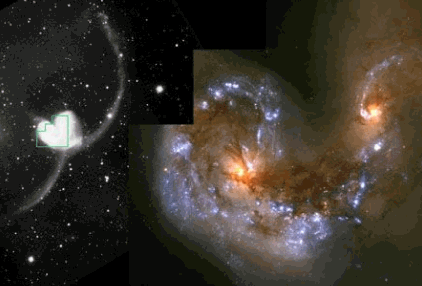Interacting galaxies were pretty common in the early
Universe. Gravity influence of tight clusters of
galaxies resulting in several different types of
merging:
- Interacting
galaxies - close proximity of
two or more galaxies results in tidal
distortions
- Merging
galaxies - sometimes called
colliding
galaxies, where two
galaxies are in
the process of joining together
- Starburst
galaxies - these are merging or
colliding
galaxies that involve close proximity
of the nucleus of each
galaxy sparking sudden
star births
 |
Click on the image to view a video of a
typical merger.
In this case, the two interacting
galaxies will merge into one larger galaxy
(video care of
Swinburne Astronomy Online). |
It is suggested that elliptical
galaxies are the
result of two merging spiral
galaxies. The evidence
of this is the distribution of elliptical galaxies
in present day clusters. It is also suggested that
the fuel required for an AGN is from galaxy mergers.
It seems strange that in an expanding Universe
that colliding
galaxies would be rare, but as we
have seen already
galaxies exist in clusters. If the
cluster is compact enough, influence by gravity is
enough to initiate a collision. An example is our
own
local group: all
galaxies are moving away from
us save one -
the Andromeda galaxy (M31) is moving
toward us at about 300 km/s. In about 2 to 3 billion
years, the two will finally interact.
 |
An interacting galaxy, like this image
of Arp273, demonstrates how the gravity if
the lower
galaxy is affecting the spiral
structure of the upper
galaxy. Such
interactions cause what is called
tidal
distortions. It seems strange that the
smaller
galaxy would cause such distortions
in a larger
galaxy, but in this case the
lower galaxy is an AGN (not seen in this
image). |
63 million light years away, the poster child of
galaxy mergers is the Antennae, or NGC4038 and 4039:

These two
galaxies will eventually coalesce into
a single, larger galaxy.
Sometimes if a
galaxy merger involves the nucleus
of a
galaxy, violent
star formation results. An
example is the nearby
galaxy M82:

This irregular shaped
galaxy is the result of a
smaller
galaxy that has merged near the core of the
larger galaxy that has not only created the single
galaxy we see, but intense
star formation in the
heart of the
galaxy.

(Image credit: Brooks/Cole Thomson Learning)
What has happened here is that massive dust
clouds help to create massive
stars that "live fast
and die young" that eventually
supernova. The
supernova stimulates nearby dust clouds to form more
large
stars and the cycle continues - rapidly.

(Image credit: Brooks/Cole Thomson Learning) |
Nearby
galaxies have also been observed
undergoing merging. An example is the
Stephan's Quintet - a nearby compact
cluster.
In reality, the
galaxy in the lower left
of the image is a part of the observed
cluster but is not a physical member of the
cluster - as measure by
redshift.
The top
three
galaxies are a part of the compact
cluster and are interacting. |
Some of the current research involving the
merging of
galaxies include:
- Correlation between
galaxy merging and Seyfert galaxies
- Interacting
galaxies provide fuel for AGN -
AGN then stimulates starburst formation
- Correlation between far infra-red emission
and starburst
galaxies
By continuing to study merging and interacting
galaxies Astronomers hope to understand the process
of
galactic evolution.
Back to Top |

